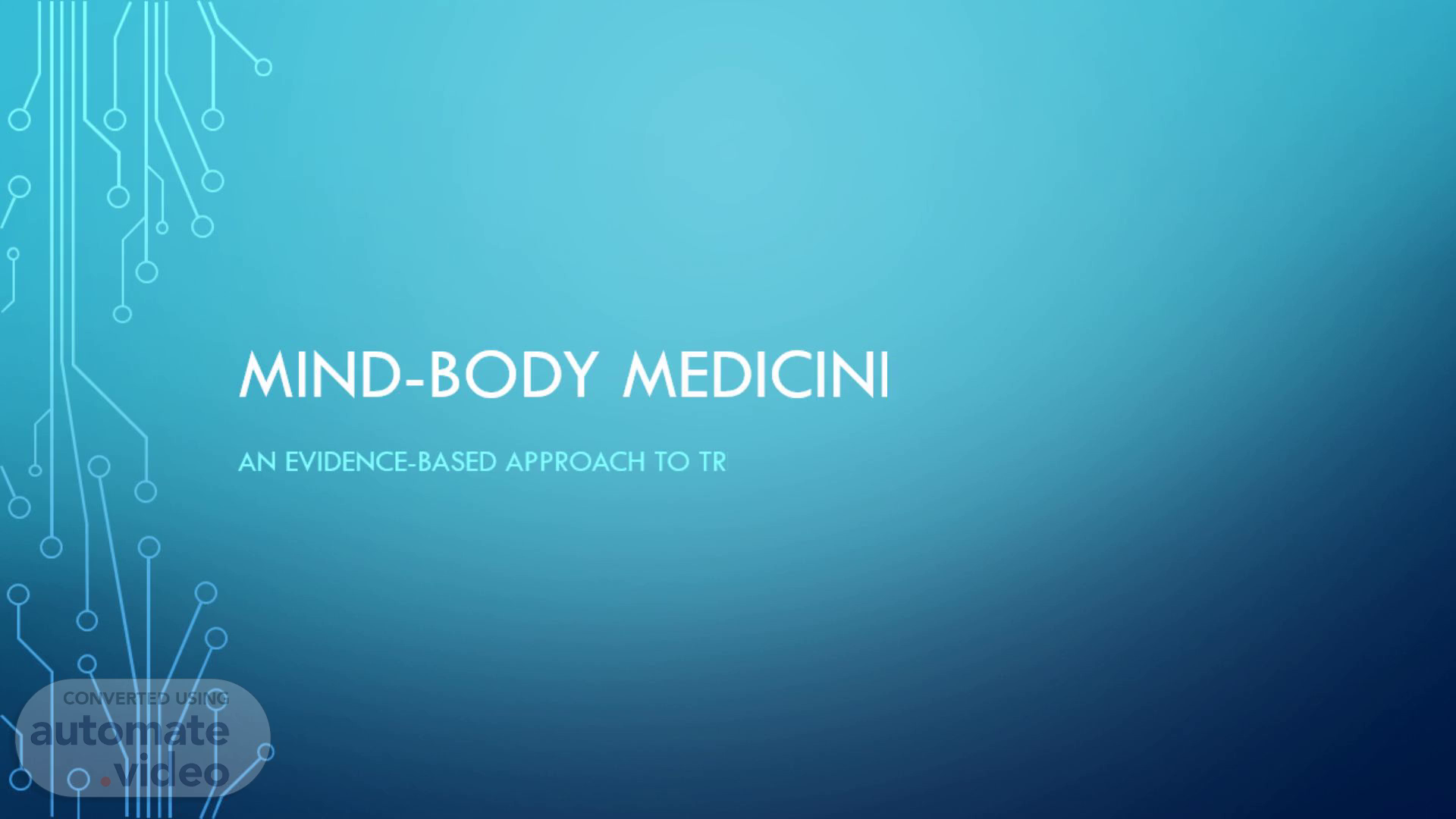Scene 1 (0s)
Mind-body medicine. An evidence-based approach to treating trauma.
Scene 2 (7s)
[Audio] Mind-Body Medicine Introduction What is it? Evidence-based program created to reverse the psychological and biological damage caused by trauma Mind-body practice encompasses activities with the intent to use the mind to impact physical functioning and improve health How? It improves symptoms of PTSD Although conventional pharmacologic and psychotherapeutic interventions have shown some proven efficacy in the treatment of.
Scene 3 (38s)
[Audio] The (neuro)science behind it Mind-body interactions play a critical role in the development and treatment of PTSD. Trauma disrupts the balance between the brain and body, with the nervous system often becoming hyper-aroused or stuck in a state of heightened threat perception. This dysregulation involves the hypothalamic-pituitary-adrenal (HPA) axis, which governs the stress response, and the vagus nerve, which regulates emotional and physiological states. Chronic stress and unresolved trauma can manifest physically, leading to symptoms such as increased heart rate, gastrointestinal issues, and muscle tension. Conversely, the body can be a gateway for healing PTSD, as mind-body practices like mindfulness, yoga, and somatic therapy help regulate the nervous system, improve heart rate variability, and re-establish a sense of safety. These approaches foster a deeper connection between the mind and body, allowing individuals to process trauma and regain control over their emotional and physical responses. Mind-body interactions studies have shown that stress-related disorders may be induced by allostatic load, the "body cost" for maintaining homeostasis, and imbalance in the autonomic nervous system (ANS), with over-activity of the sympathetic nervous system (SNS) and under-activity of the parasympathetic nervous system (PNS). The vagus nerve (bi-directional) The "brain-gut axis" communicates between the brain and the gastrointestinal tract. It regulates gastrointestinal homeostasis and connects emotional and cognitive areas of the brain with gut functions. Activates the parasympathetic nervous system, meaning it promotes "rest and digest" functions in the body. Increase in heart rate variability (HRV) The vagus nerve plays a key role in regulating heart rate variability (HRV), which is the variation in the time intervals between consecutive heartbeats. When the vagus nerve is active, it signals the heart to slow down and promotes variability in heart rate. During exhalation, vagal activity increases, slowing the heart rate. During inhalation, vagal activity decreases, allowing the heart rate to increase slightly. This dynamic interplay contributes to respiratory sinus arrhythmia, a natural variation in heart rate linked to breathing patterns, and a sign of healthy HRV. Activate the parasympathetic nervous system PTSD patients show characteristics of higher sympathetic and lower parasympathetic activity at basal levels compared to healthy individuals.
Scene 4 (3m 32s)
[Audio] Treatment of posttraumatic stress disorder in postwar Kosovar adolescents using mind-body skills groups: a randomized controlled trial. This study was done to evaluate whether or not participating in Mind-body medicine groups decreased symptoms of PTSD. 82 adolescents who met the criteria for PTSD were randomly assigned to either 12-session mind-body medicine groups or a waitlist control group. The adolescents that were assigned to the mind-body groups had significantly lower PTSD symptoms than the ones in the control group. These results were maintained through the 3-month follow-up. Treatment of Posttraumatic Stress Disorder in Postwar Kosovo High School Students Using Mind–Body Skills Groups: A Pilot Study. This study was done to determine if mind-body medicine techniques decreased posttraumatic stress scores using the Posttraumatic Stress Reaction Index questionnaire on 139 postwar Kosovo high school students. Students who participated in the 6-week program that included meditation, biofeedback, drawings, autogenic training, guided imagery, genograms, movement, and breathing techniques reported a significant decrease in Posttraumatic stress scores. Mind-Body Skills Groups for Posttraumatic Stress Disorder and Depression Symptoms in Palestinian Children and Adolescents in Gaza . This study evaluated the effectiveness of a 10-session mind-body skills group that included meditation, guided imagery, breathing techniques, autogenic training, biofeedback, genograms, and self-expression through words, drawings, and movement on 129 children who met the criteria for PTSD in Gaza. Among these children, there was a significant increase in PTSD and depression symptoms, as well as a decrease in the sense of hopelessness. These results were mostly maintained by the 7-month follow-up..
Scene 5 (5m 39s)
[Audio] The format and modalities 10 group sessions (Group options) Meet weekly in a group Yoga Meditation Guided imagery, breathing techniques Autogenic training Biofeedback Genograms Self-expression through words, drawings, and movement.
Scene 6 (5m 57s)
[Audio] What else is it good for? Mind-Body Medicine practices can reverse the negative health effects of chronic stress by decreasing levels of stress hormones in the body. Immune system Anxiety Atrial fibrillation and other arrhythmias Cancer Coronary artery disease Chronic pain conditions (back and neck pain, fibromyalgia, headaches, osteoarthritis and TMJ) Depression Gastrointestinal conditions (gastroesophageal reflux, irritable bowel syndrome, Crohn's disease and ulcerative colitis) Hypertension Insomnia Menopause symptoms Multiple sclerosis Psoriasis Rheumatoid arthritis and other autoimmune conditions.
Scene 7 (6m 42s)
[Audio] James S. Gordon Mind-body medicine practices have existed since ancient times. However, James S. Gordon, a National Institute of Mental Health (NIMH) research psychiatrist, founded the Center for Mind-Body Medicine (CMBM) in 1991. "His vision was to make self-awareness, self-care, and group support central to all healthcare, to the training of health professionals, and the education of our children, to create a healing community and a community of healers." CMBM has since evolved into an international effort. Their faculty includes 175 members who have trained over 7,000 clinicians, educators, and community leaders in the practice of CMBM, who, in turn, have also brought CMBM to hundreds of others. CMBM heals trauma around the world..
Scene 8 (7m 41s)
[Audio] Thank you. Thank you.
